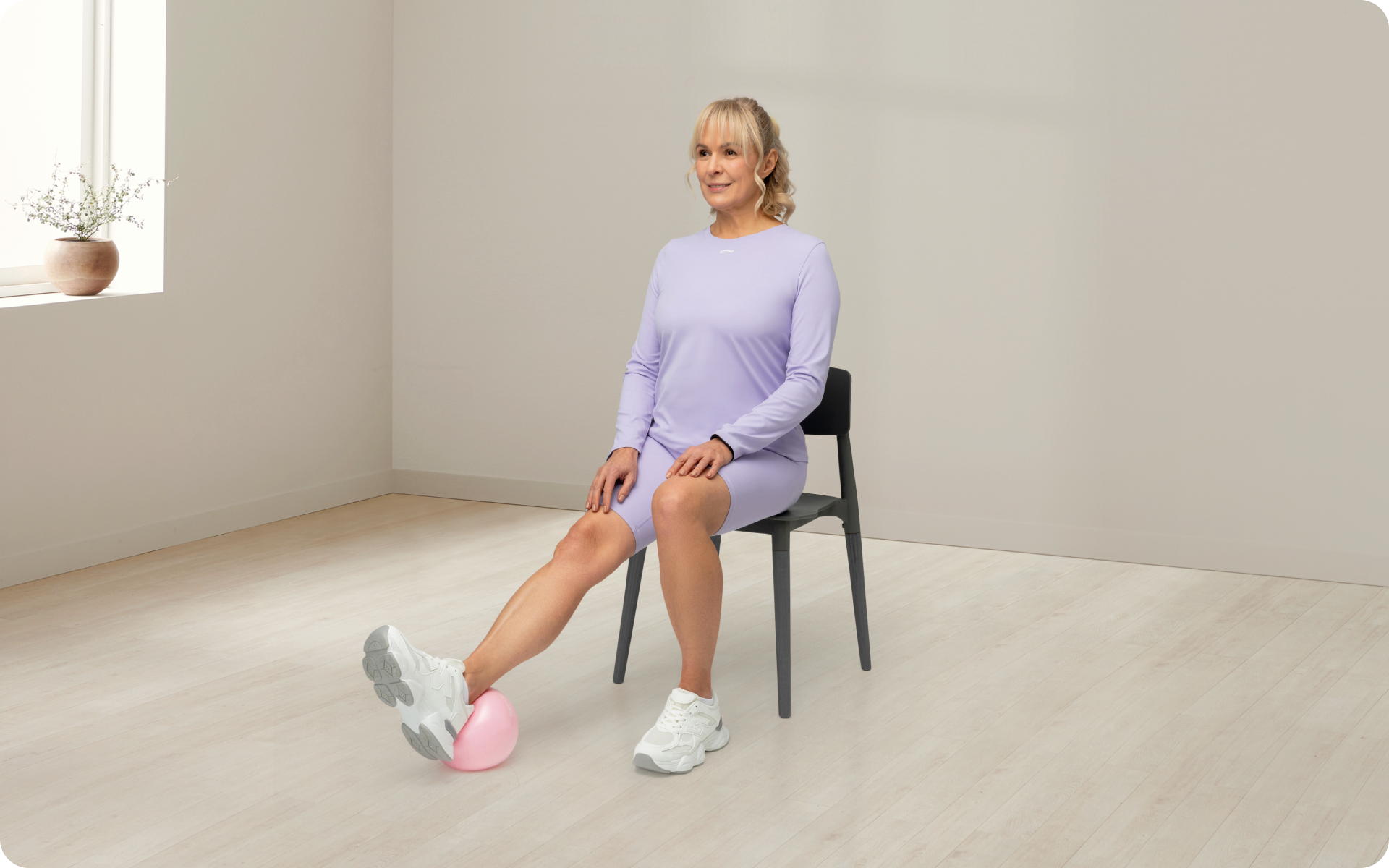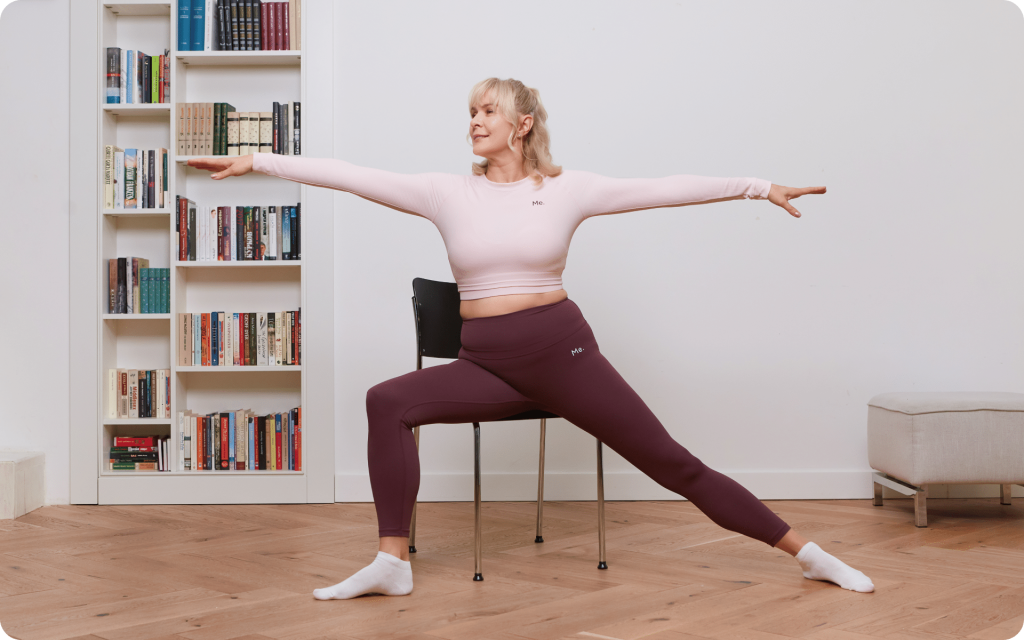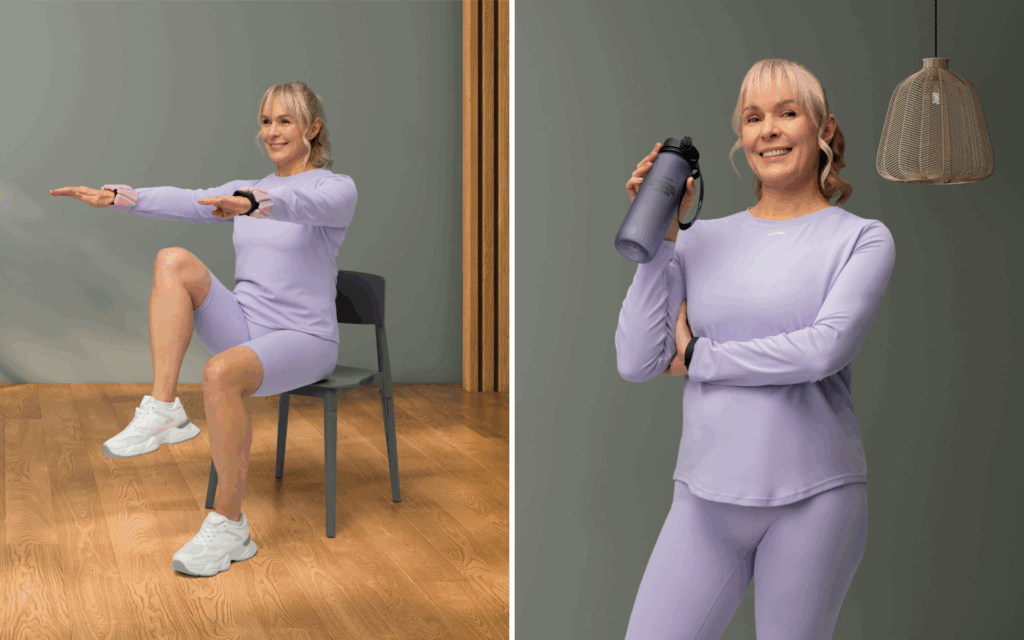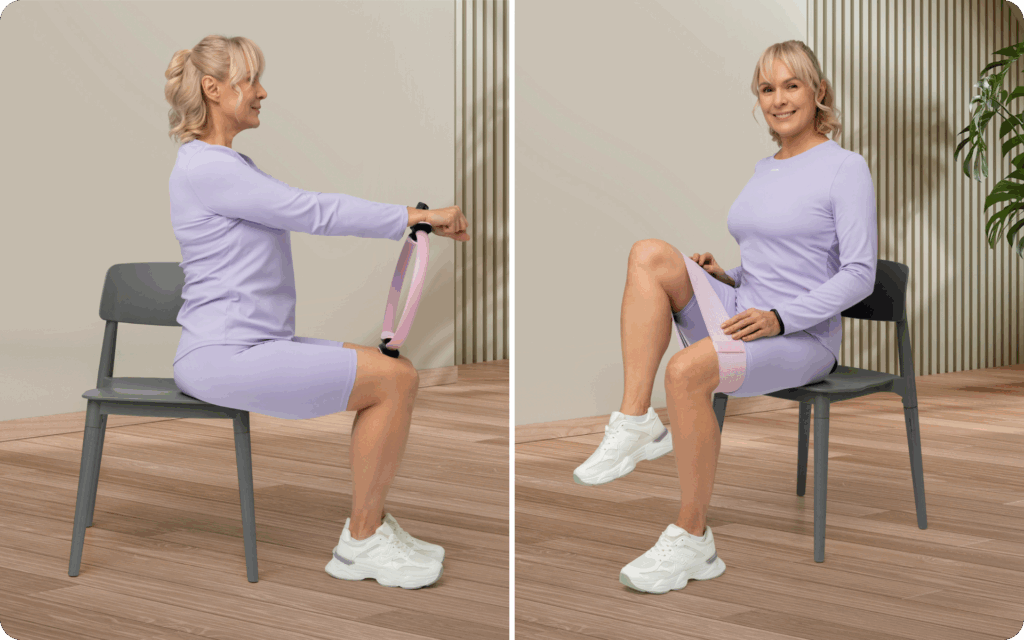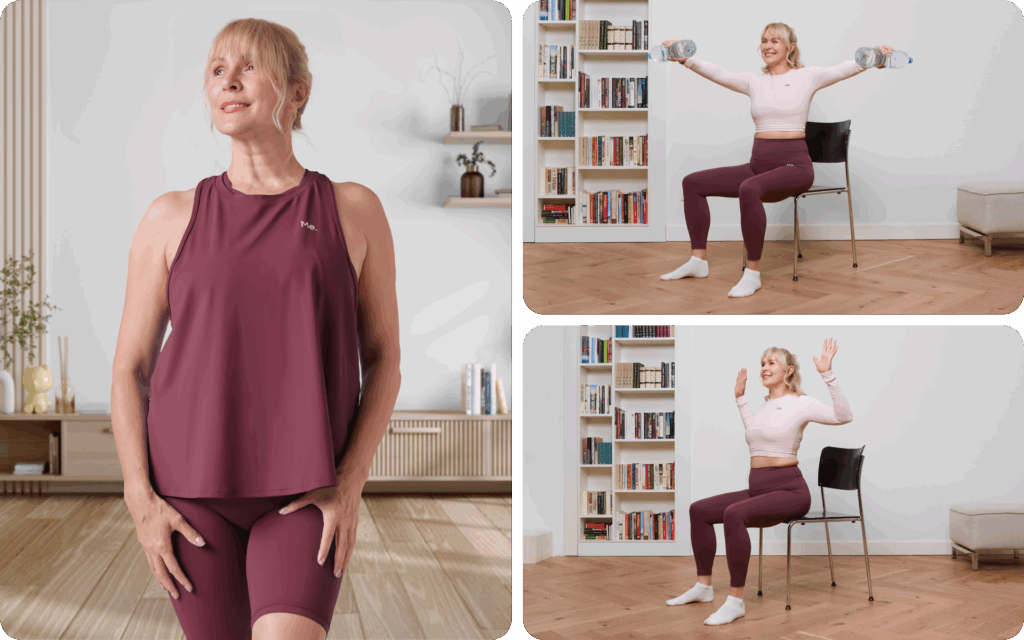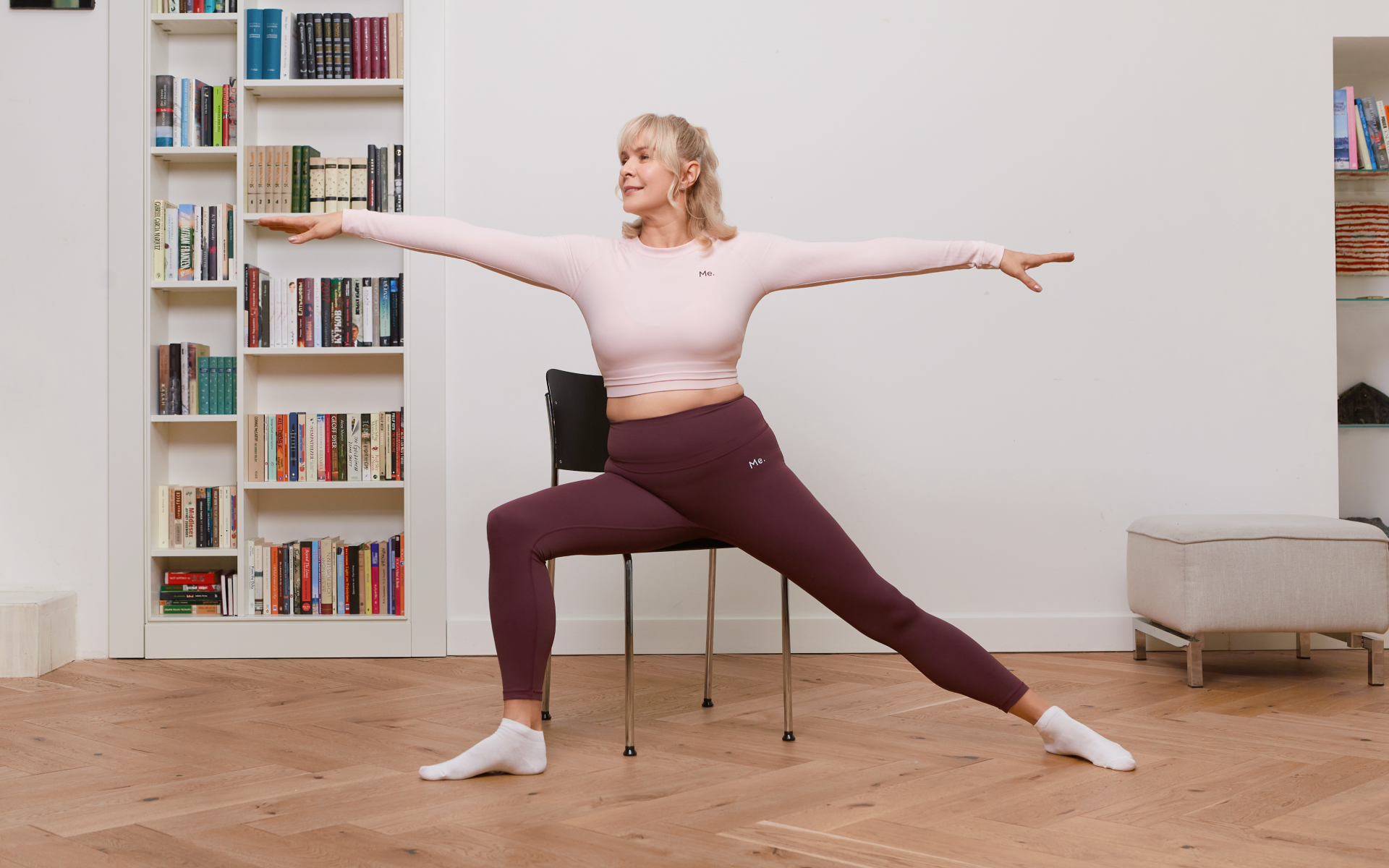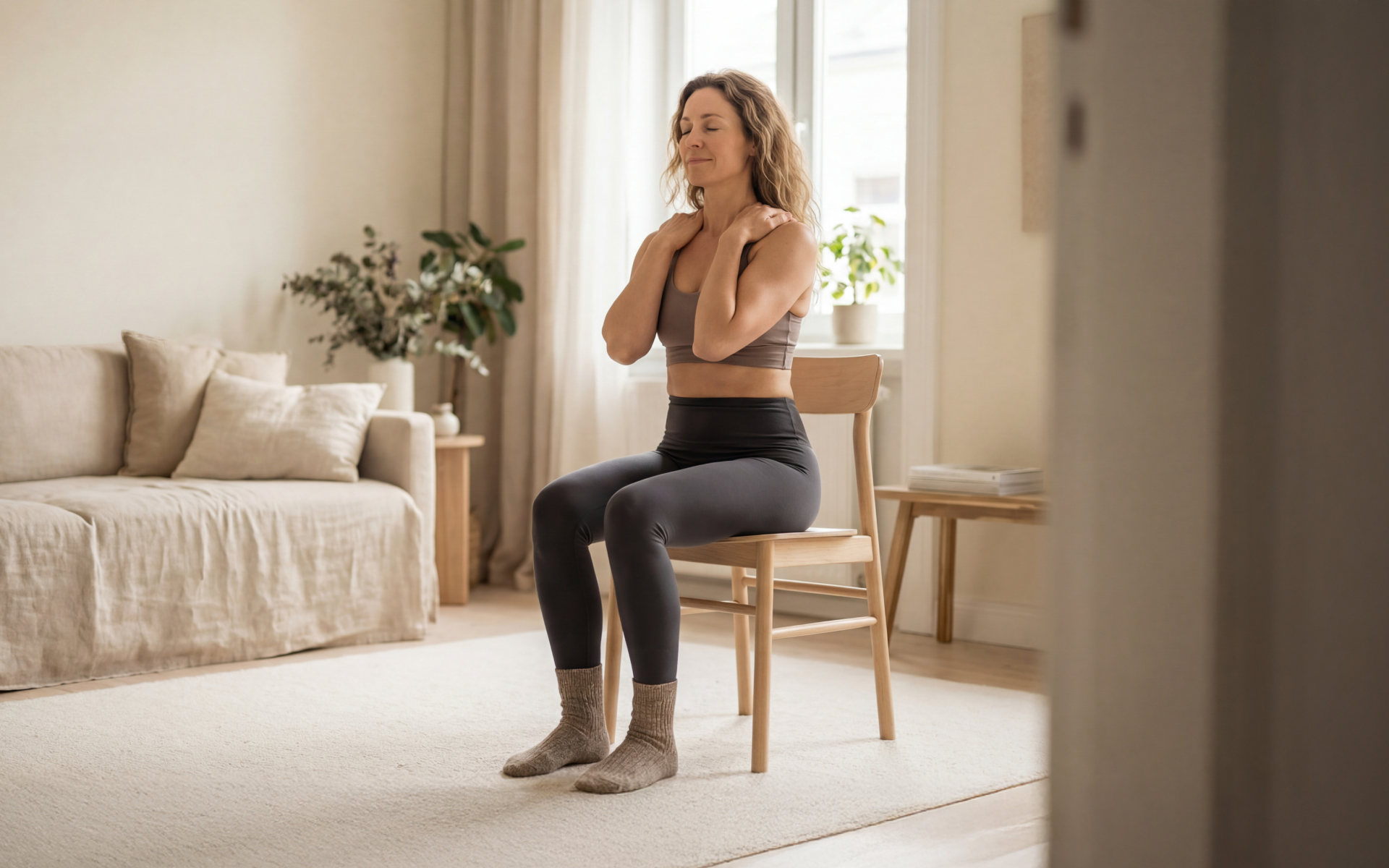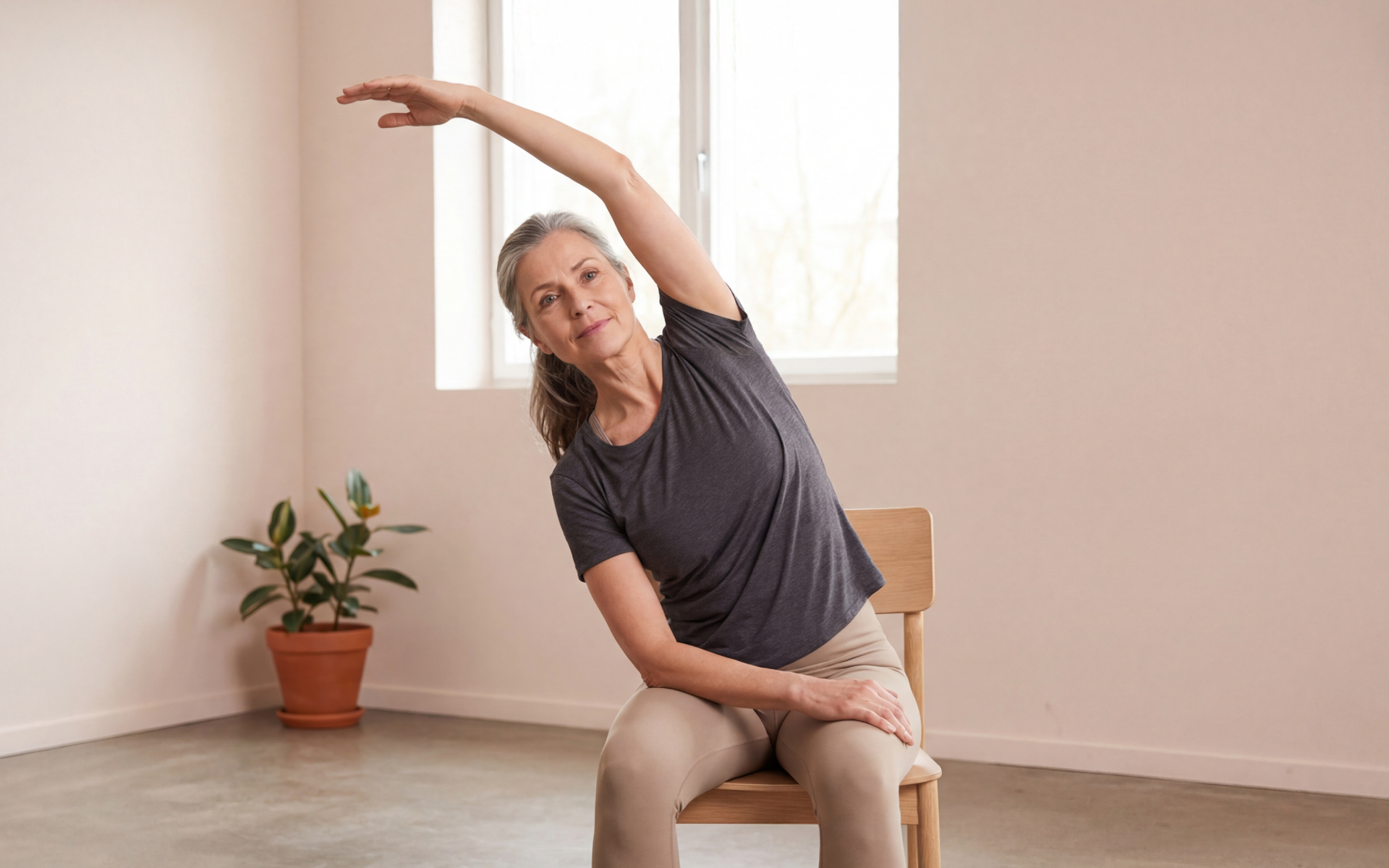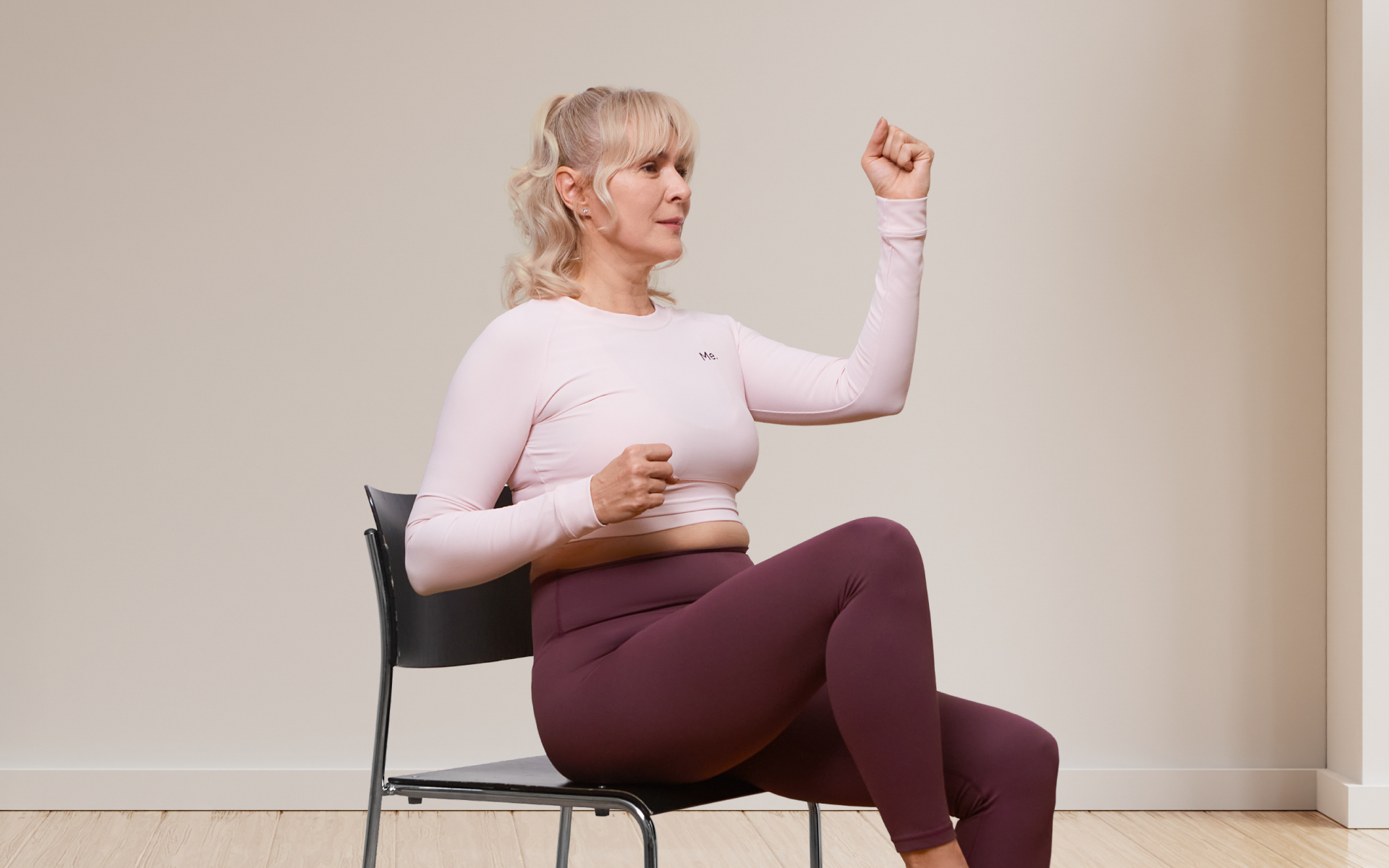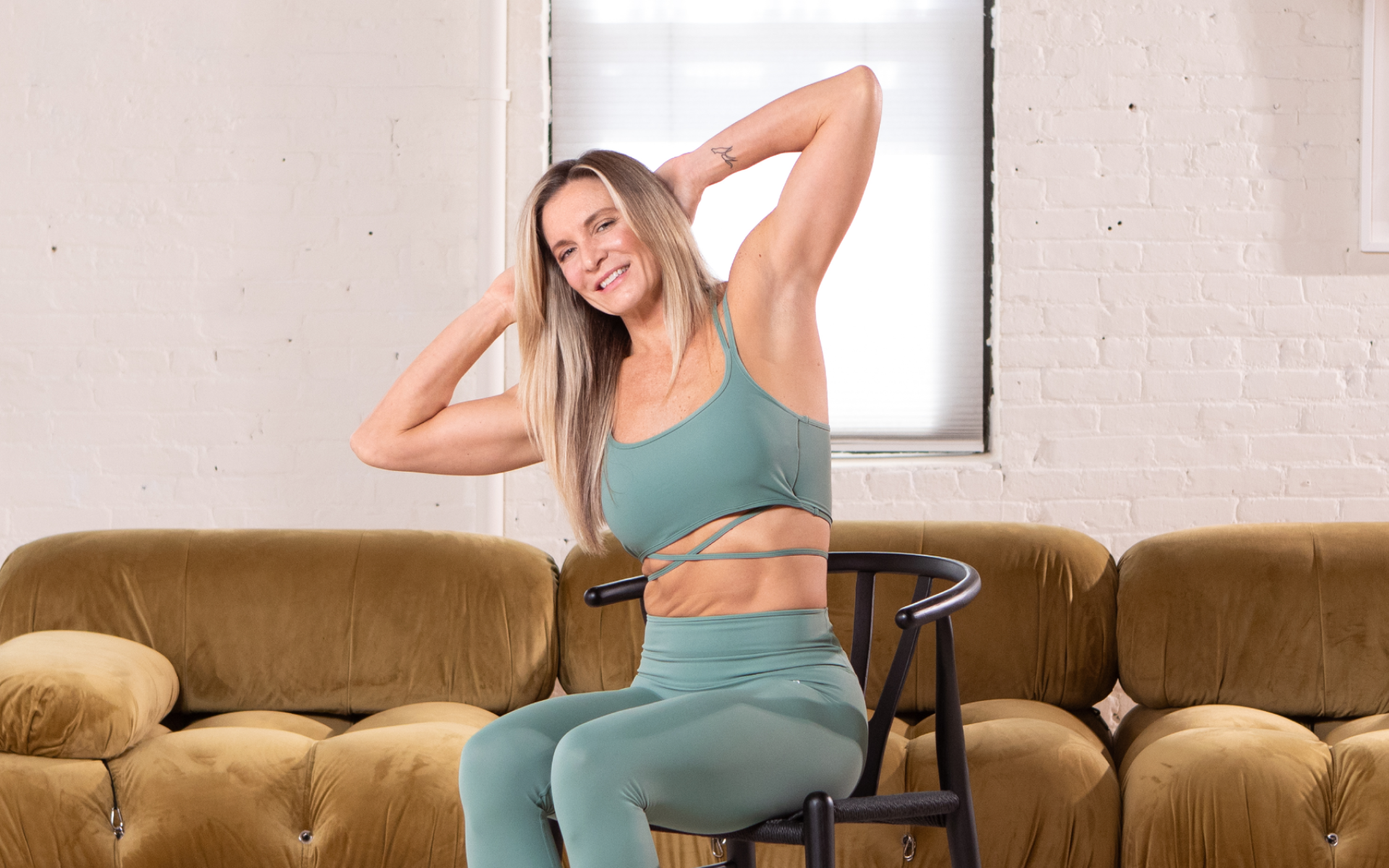Chair yoga honors the core principles of yoga – mindfulness, movement, and breath – while offering a format that anyone can engage with (1).
This practice is ideal for beginners as it removes common worries such as flexibility or experience. It focuses on small, intentional movements and breathwork, giving you a gentle introduction to the calming benefits of yoga.
All you need is a sturdy chair and a little space to move. Start by creating a calm, quiet spot where you can focus without distractions. Wear comfortable clothing that lets you move freely.
You’ll start with seated poses and progress to light stretches using the chair for support.
This guide will walk you through ten practical chair yoga ideas to help you get started.
What Are Some Chair Yoga Ideas?
Below are 10 beginner-friendly poses that you can try right in your chair:
1. Seated Mountain Pose
- Sit up tall with your feet flat on the floor, aligning your knees over your ankles.
- Rest your hands on your thighs or by your sides.
- Lengthen your spine and imagine a string gently pulling you upward from the crown of your head.
- Take a few deep breaths, feeling grounded through your feet and lifted through your posture.
2. Cat-Cow Stretch
- Place your hands on your knees.
- On an inhale, arch your back, lift your chest, and look slightly upward (cow pose).
- On an exhale, round your back, tuck your chin toward your chest, and gently press your hands into your knees (cat pose).
- Flow through these two movements for 5-8 breaths.
3. Chair Forward Fold
- Sit toward the edge of your chair with your feet hip-width apart.
- Take a deep breath in, then exhale as you hinge forward from your hips.
- Allow your arms to dangle toward the floor or rest them on your thighs for support.
- Hold for a few breaths, then slowly roll back up to a seated position.
4. Seated Spinal Twist
- Sit tall and place your right hand on the outside of your left thigh.
- Place your left hand on the back of the chair for support.
- On an inhale, lengthen your spine, and on an exhale, gently twist to the left.
- Hold for a few breaths, then repeat on the other side.
5. Seated Warrior I
- Sit sideways on your chair with your right thigh supported and your left leg extended back, toes tucked under.
- Square your hips forward and lift your arms overhead.
- Hold for a few breaths, feeling the stretch in your left hip.
- Switch sides and repeat.
6. Seated Side Stretch
- Sit tall with your feet flat on the floor.
- Rest your left hand lightly on the seat of the chair.
- Reach your right arm overhead, leaning gently to the left to stretch your side body.
- Hold for a few breaths, then switch sides.
7. Seated Figure Four Stretch
- Sit tall and place your left ankle on top of your right knee.
- Flex your left foot and gently press down on your left knee for a deeper stretch.
- Hold for a few breaths, staying relaxed and breathing deeply.
- Switch sides and repeat.
BetterMe will shake off your mental funk, rid you of your energy-zapping habits, and help you sculpt the body of your dreams. Intrigued? Hurry up and change your life for the better!
8. Chair Eagle Arms
- Sit tall and extend your arms out in front of you.
- Cross your right arm over your left at the elbows, bending both arms so your palms face each other (or as close as possible).
- Lift your elbows slightly and hold for a few breaths to stretch your shoulders.
- Unwind your arms and switch sides.
9. Seated Hamstring Stretch
- Sit on the edge of your chair and extend your right leg straight out, resting your heel on the floor.
- Flex your foot and hinge forward slightly from your hips to feel the stretch in the back of your leg.
- Hold for a few breaths, keeping your spine long.
- Switch sides and repeat.
10. Seated Relaxation
- Sit back in your chair, resting your feet flat on the floor and your hands on your thighs.
- Close your eyes and take slow, deep breaths, allowing your body to fully relax.
- Stay here for 1-2 minutes, focusing on the rhythm of your breath.
Explore more postures you can try as a beginner in our previous post: Seated Chair Yoga Poses.
Read more: 10-Minute Chair Yoga Flow for Beginners
Is Chair Yoga Really Legit?
While research is emerging, chair yoga can be linked to several potential benefits, primarily rooted in how the body reacts to gentle physical movement, breath control, and mindfulness. Below, we explore these benefits:
- Improved Flexibility and Range of Motion
Chair yoga involves dynamic stretches, such as seated hamstring stretches and spinal twists, which help lengthen muscles and promote joint mobility. These movements work within a safe range for the individual, which makes them suitable for people with stiffness or a limited range of motion.
By gently elongating muscle fibers and moving joints through their natural planes, chair yoga may make daily activities such as reaching or bending more manageable over time (2).
- Enhanced Muscle Strength
Many chair yoga poses incorporate isometric contractions, where muscles are engaged without significant movement (3). For example, seated variations of warrior pose or side stretches engage the core, leg, and arm muscles. Strengthening these muscles provides better joint stability and improved functional capabilities, which reduces overuse strain on other parts of the body.
- Improved Posture and Alignment
The focus on spinal alignment in chair yoga helps correct poor posture, which is common in individuals who spend long hours sitting or lack regular activity (1).
Exercises such as seated mountain or cat-cow encourage an upright posture and mobility in the spine, which reduces tension in the back and shoulders. Better posture helps distribute weight evenly across joints, which prevents unnecessary pressure on the hips or knees.
- Better Circulation
Gentle movements in chair yoga stimulate blood flow, which improves oxygen delivery to tissues and enhances cardiovascular health (4). Movements such as seated forward folds and gentle stretches promote venous return, encouraging circulation and reducing the risk of stiffness or swelling in the lower extremities.
- Reduced Stress and Mental Clarity
As with traditional yoga, chair yoga often integrates focused breathing (pranayama) and mindfulness. These elements activate the parasympathetic nervous system, promoting relaxation and decreasing levels of stress hormones like cortisol. Over time, the practice can enhance an individual’s ability to focus and manage stress (5), which can lead to better mental clarity and emotional balance.
- Safer Mobility for Special Populations
Chair yoga can be particularly valuable for individuals who are recovering from surgery, have arthritis, or are living with conditions such as dementia or Parkinson’s disease (6). By using a chair to provide stability, these individuals can move safely while reducing their injury risk. It’s also a way to gradually build confidence in movement without overloading the muscles or joints.
- Balance and Core Stability
Although chair yoga doesn’t involve standing postures for balance, many seated poses challenge the practitioner’s core stability. For example, practices such as seated twists or reaching side stretches activate the deep abdominal muscles that play a key role in maintaining upright posture and preventing falls. Over time, this core strengthening may translate into improved steadiness balance, which is essential for older adults (7).
- Pain Management
Slow, controlled movements can help reduce muscle tension, which contributes to pain in conditions such as fibromyalgia or chronic lower-back pain (8). The emphasis on breathwork further supports this, as it encourages relaxation in the nervous system, which may lower pain perception. Regular practice could potentially improve overall comfort in daily activities, although individual responses will vary.
- Accessibility and Inclusivity
The greatest appeal of chair yoga is its accessibility. By removing common barriers such as flexibility requirements or floor-based movements, it offers an entryway to yoga for those who may otherwise avoid it. While chairs provide a supportive base, individuals still benefit from movement, stretching, and mindfulness that is tailored to their needs.
Read more: Chair Yoga Office Workout: Simple Exercises for a Healthy Workday
Can You Get a Toned Body with Chair Yoga?
Chair yoga offers gentle movement and muscle engagement, but its potential to create a “toned” body has limitations. Our previous post goes into great detail about the sitting yoga pose.
Chair Yoga Has Limited Muscle Mass Building Potential
Chair yoga involves movements that engage various muscle groups. For example, isometric holds such as seated warrior or chair eagle arms require muscles to work to stabilize the body. Over time, this can help improve muscle endurance and strength.
However, the intensity of chair yoga is relatively low. It isn’t likely to build significant muscle mass compared to practices such as weightlifting or dynamic, high-intensity yoga styles. Instead, chair yoga focuses on improving functional strength. This means strengthening the muscles needed for everyday movement and support.
Intense sweat sessions, working weight loss tips, lip-smacking recipes come in one package with the BetterMe: Health Coaching app—all at your fingertips, start transforming your life now!
It Also Has Limited Fat-Burning Potential
Any form of movement increases calorie expenditure. Chair yoga gently increases your heart rate and boosts circulation, which contributes to calorie burn. However, its intensity is mild. The energy demand may not be enough to create a calorie deficit for noticeable weight loss or fat burning, particularly if done as a standalone practice.
For context, moderate activities such as brisk walking or running often create a greater metabolic impact (9). That being said, chair yoga can serve as a starting point for individuals who are new to exercise or have physical limitations. It can complement other forms of activity for an overall calorie-burning effect.
It Can Be Part of a More Detailed Toning Routine
Chair yoga can enhance posture, muscle stability, and range of motion. Small improvements in muscle tone may occur with consistent practice over time. Its focus on deep breathing and mindfulness can also reduce stress and promote better eating and lifestyle habits (10), which indirectly supports overall fitness goals.
If muscle toning or fat loss is a primary objective, chair yoga would likely need to be part of a larger fitness routine. Combining it with strength training, cardio, and a balanced diet can produce more noticeable results.
Does Chair Yoga Really Work to Lose Weight?
Chair yoga may not be the most effective form of exercise for weight loss on its own. That being said, it can certainly contribute to a healthy and sustainable weight loss journey.
- Consistent practice of chair yoga can improve muscle tone and promote mindfulness and stress reduction, which are important factors for maintaining a healthy weight.
- Incorporating chair yoga into a regular fitness routine can add variety and help prevent burnout or injury from other forms of exercise.
- It can also provide low-impact options for individuals with physical limitations or injuries that may prevent them from engaging in more strenuous activities.
- The mind-body connection fostered by chair yoga can help individuals become more aware of their eating habits and make healthier choices.
- The practice of mindfulness and breathing techniques can also help with stress management, which reduces the likelihood of using food as a coping mechanism.
Yes, chair yoga can be considered a form of exercise, particularly for individuals who have limited mobility or physical restrictions. According to exercise guidelines from organizations such as the World Health Organization (WHO) and the American Heart Association (AHA), physical activity includes any movement that engages muscles and raises energy expenditure above resting levels (11, 12). Chair yoga fulfills these criteria by incorporating strength, flexibility, and mindfulness techniques. Burning 1,000 calories while sitting is challenging and unlikely without the incorporation of vigorous movement. For context, activities such as jogging or cycling require a significant effort to reach this calorie expenditure. While seated, you can increase calorie burn by performing dynamic exercises such as seated marches, resistance band movements, or arm raises. But even these repetitive fast-paced movements would take a long time to get you to that 1,000 calories burned goal. Other options include engaging in high-rep, low-resistance strength exercises or using hand weights. In addition, promoting a slight calorie deficit through dietary adjustments will complement and enhance your overall calorie expenditure. Chair yoga can improve certain aspects of fitness, such as flexibility, balance, and core stability. Over time, it may contribute to better posture, reduced muscle tension, and functional strength. However, whether chair yoga alone can get someone “in shape” depends on their fitness goals. For significant changes in muscle tone, endurance, or fat loss, more intense or varied forms of exercise may be needed in addition to chair yoga. It functions best as part of a well-rounded fitness routine, particularly for individuals who are looking for a gentle approach to physical activity. Both chair yoga and wall Pilates have unique benefits and the choice depends on individual needs and goals. Chair yoga is typically more focused on gentle stretching, breathwork, and mindfulness. It’s an excellent option for those with limited mobility, older adults, or beginners who are looking for a low-impact practice to enhance their range of motion or reduce stress. On the other hand, wall Pilates is more aligned with strength and core conditioning. Incorporating wall support encourages precise muscle engagement and alignment, which can build stronger muscles and improve posture. You can also switch things up by doing standing chair yoga poses. Learn more in our previous blog post.Frequently Asked Questions
Does chair yoga count as exercise?
How can you burn 1,000 calories while sitting?
Can you get in shape with chair yoga?
Which is better, chair yoga or wall Pilates?
The Bottom Line
Chair yoga offers a promising way to incorporate healthy movement for many people. For those who are managing physical limitations or simply looking for a gentle approach to movement, chair yoga could be a way to explore the principles of yoga with confidence. Always consult a healthcare professional or an experienced instructor before you start any new exercise regimen to make sure it’s right for your personal needs.
DISCLAIMER:
This article is intended for general informational purposes only and does not serve to address individual circumstances. It is not a substitute for professional advice or help and should not be relied on for making any kind of decision-making. Any action taken as a direct or indirect result of the information in this article is entirely at your own risk and is your sole responsibility.
BetterMe, its content staff, and its medical advisors accept no responsibility for inaccuracies, errors, misstatements, inconsistencies, or omissions and specifically disclaim any liability, loss or risk, personal, professional or otherwise, which may be incurred as a consequence, directly or indirectly, of the use and/or application of any content.
You should always seek the advice of your physician or other qualified health provider with any questions you may have regarding a medical condition or your specific situation. Never disregard professional medical advice or delay seeking it because of BetterMe content. If you suspect or think you may have a medical emergency, call your doctor.
SOURCES:
- Chair Yoga (2021, journals.lww.com)
- Impact of 10-weeks of yoga practice on flexibility and balance of college athletes (2016, ncbi.nlm.nih.gov)
- Exploring the therapeutic effects of yoga and its ability to increase quality of life (2011, ncbi.nlm.nih.gov)
- Enhancing Cardiovascular Health: The Positive Impact of Yoga on Blood Flow and Circulation (2024, researchgate.net)
- Fifteen Minutes of Chair-Based Yoga Postures or Guided Meditation Performed in the Office Can Elicit a Relaxation Response (2012, ncbi.nlm.nih.gov)
- The Effectiveness of Chair Yoga in Older Adults: A Literature Review (2023, researchgate.net)
- Yoga Exercise Intervention Improves Balance Control and Prevents Falls in Seniors Aged 65+ (2022, ncbi.nlm.nih.gov)
- Yoga for People With Chronic Pain in a Community-Based Setting: A Feasibility and Pilot RCT (2019, ncbi.nlm.nih.gov)
- The Regulation of Fat Metabolism during Aerobic Exercise (2020, ncbi.nlm.nih.gov)
- Yoga’s potential for promoting healthy eating and physical activity behaviors among young adults: a mixed-methods study (2018, ncbi.nlm.nih.gov)
- Physical activity (2024, who.int)
- American Heart Association Recommendations for Physical Activity in Adults and Kids (2024, heart.org)
